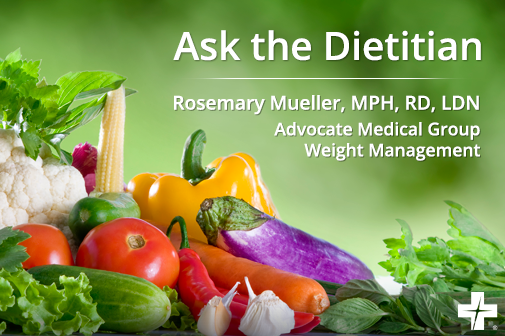Your ‘Ask the Dietitian’ questions answered

Earlier this month, readers submitted their diet and nutrition questions. Today Rosemary Mueller, MPH, RD, LDN, who is a registered dietitian and licensed dietitian nutritionist with Advocate Medical Group Weight Management is answering a few of these questions.
Thank you to all who submitted a question. Due to the overwhelming response from our readers, not all the questions could be answered. During the month of October, there will be an additional opportunity to submit your questions.
Sue: Especially in summer, I tend to eat less meat. I’m worried that I am not getting enough protein. What is the daily amount for good health?
Rosemary: The Recommended Dietary Allowance (RDA) for protein (the amount of protein needed to support health) varies with Life Stage Group (i.e., age). The RDA is actually based on a formula of .8 grams per kilogram of weight per day for healthy adults and 1.1 grams of protein per kilogram for pregnant women.
For a healthy adult women above the age of 18, that is about 46 grams of protein per day, and about 71 grams of protein per day during pregnancy.
For men over age 18, that number is approximately 56 grams of protein per day. Although 46 grams may sound like a lot of protein each ounce of fish, meat or poultry contains 7 grams per one ounce portion. An egg contains 7 grams of protein as does a typical glass of milk or serving of yogurt. Egg, meat, fish, poultry and dairy products contain “complete” protein which means all the essential amino acids are provided when eating those food items.
Protein sources from plants include legumes, nuts, seeds, vegetables and grains. Plant sources of protein add to and support good total protein consumption, but because they have limited amino acids, they are best eaten in combinations, such as legumes and grains or nuts/seeds and grains. This provides all the essential amino acids which is especially important for vegetarians. Also, a serving of a grain contributes about two more grams of protein and a serving of vegetable (1/2 cup cooked or 1 cup raw) contributes two grams as well.
Most of us obtain more than sufficient protein when eating a balanced diet.
Jeff: When it comes to eating non-organic fruits is it actually safer to choose fruits that typically contain less pesticides, such as pineapples, than to clean and eat fruits that are known to have high pesticides, like strawberries and apples?
Rosemary: It is probably impossible to totally limit exposure to pesticides of every kind even if you were to always choose organic produce because we cannot control the wind and where it blows across crop fields. You can limit your exposure by thoroughly scrubbing apples or other fruits and vegetables with hard, edible skins with a clean produce-appropriate scrub brush under cold, clean running water.
The FDA does limit the amount of pesticides allowed in agriculture, but softer fruits such as berries, cherries, pears and vegetables like peppers tend to be slightly higher in pesticides although they are still within the “allowed amounts” of pesticide residues.
I encourage that consumption of a wide variety of fruits and vegetables which are rotated through the diet. Do the best you can to alternate your choices, wash produce, remove outer leaves and eat organic when possible – but focus on a colorful variety of produce from different sources. There are just too many benefits of in terms of nutrients and phytochemicals found in the produce world to abstain from any one based on pesticide concerns.
Laura: I’ve read that flax seed needs to be ground in order for our bodies to absorb its nutrients. Once it is ground, how long does it last and will freezing it help prolong its shelf life?
Rosemary: Ground up flaxseed also called flaxseed meal is generally recommended over whole flaxseed because the ground form is easier for your body to digest and absorb. Whole flaxseed may pass through your intestine pretty much undigested.
Flaxseeds or flaxseed meal should always be refrigerated in an opaque, airtight container because exposure to light will increase the degradation process. Flaxseed meal may also be frozen to extend freshness. Use flaxseed meal by the “best if used by” date on the package. If you grind your own flaxseed meal (from whole flaxseed) and store properly, your ground flaxseed meal should last for a month or longer. If flaxseed meal develops a rancid or “off” smell, discard it.
Flaxseed meal is high in dietary fiber, containing both soluble and insoluble fiber, and is a rich source of omega-3 fatty acids and lignans, which have both plant estrogen and antioxidant qualities. Flaxseed meal can also help control blood cholesterol levels.
Never eat more than 2 Tbsp. of flaxseed meal per day, remember to drink plenty of water and try to eat flaxseed meal about an hour from taking any medications.
Linda: How can I tell how much is a single serving size if I do not carry a measuring cup or scale to weigh food whenever I eat out or even at home? For example, is the size of a cassette tape an accurate measurement for a serving of lean chicken or a slice of beef? Are 12 grapes a ½ cup serving?
Rosemary: Kudos to you for diligently trying to watch portions! Learning to “eyeball” your food to gauge what’s too much and what is enough is the idea. Continue to practice thinking in “units” of food groups – such as “ounces” of protein foods, ½ cup or single portions of grain group foods, ½ cup or single portions of fruits and vegetables and teaspoon or equivalents of fats.
A registered dietitian can assist in understanding just how many “units” of each food group are appropriate for you and for your goal – whether that is to lose, maintain or even gain some weight. How many calories you need is dependent upon age, gender and your activity and the appropriate macronutrient distribution (the percentage of carbohydrate, protein and fat).
General health recommendations for adults/day include:
- 5-2 cups of fruit and 2.5-3.5 cups of vegetables per day
- 5-8 oz. of grain foods (at least half from whole grains)
- 3 cups of nonfat or low-fat dairy foods
- 5-6.6 ounces of protein (meat, fish, poultry, beans)
- No more than 5-7 teaspoons of oils, mostly from plants, fish and nuts
- A limit of 120 calories from solid fats and added sugars
Here are some guidelines for “eyeballing” a single unit of food:
- 4 oz. portion of meat/fish/poultry (meat only): The size of/density of a folded wallet or slightly larger than a deck of cards
- 1 small muffin: A tennis ball
- ½ a medium bagel: 1 hockey puck
- 1/3 cup of rice: about an open fistful
- 1 portion of cheese: four dice
- 1 serving of fruit or vegetables, cooked: 1 baseball or a fist
- 1 tsp. of oil: 2 tsp. of peanut butter, or a small, closed-fist handful of nuts
- 17 (smaller) grapes is a “unit” of fruit, equivalent to about 15 grams of carbohydrate
Remember, the total number of “units” you eat each day is dependent upon your calorie allowance. Reading food labels for a single serving size is also a good place to start.
Related Posts
Comments
One Comment
About the Author
health enews staff is a group of experienced writers from our Advocate Health Care and Aurora Health Care sites, which also includes freelance or intern writers.


















I am a diabetic and went to a dietician and now I count carbs and am very satisfied. My friend is a diabetic and her Dr. to watch her sugar that is all that was said. Confusing to me. Second question When I look at a label on food. I pay attention to the carbs. Then they give the grams of sugar under the carbs . Do I also count in the grams of sugar? Thank you